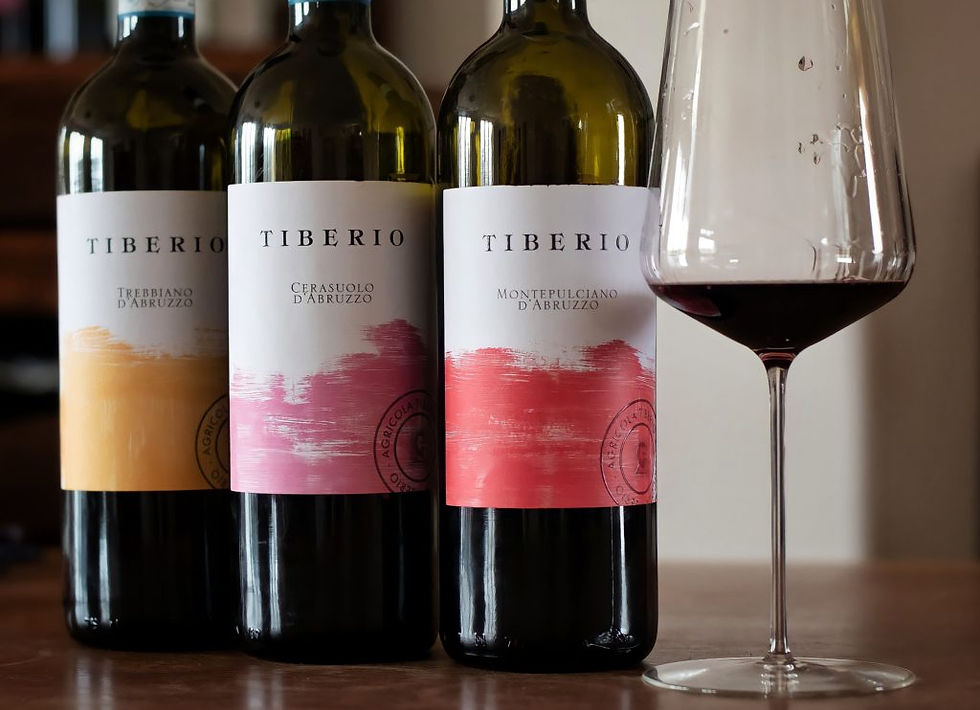A True Trebbiano
- Jul 13, 2022
- 4 min read
Driving through the hills behind the coastal plain of Abruzzo it is impossible not to feel a certain timeless quality in the gently rolling countryside. The fields, the olive groves, and the vineyards seem to be such an integral part of the landscape that surely they have been there forever. However, that is, of course, not the case. It is simply that the ebbs and flows of time and change wash through at a gentler pace here than elsewhere. If we could watch a timelapse film of this land we would see mostly slow change but interspersed with some rather more hectic times. The growth of Rome - only a hundred miles away - in the centuries before the birth of Christ, had a dramatic effect on the surrounding hinterland with forests being swept away to provide additional fields to feed a burgeoning population. But within that, there were other changes that you would see. After the destruction of Pompeii by the massive eruption of Vesuvius in 79 AD there was a shortage of wine in a society where it was an everyday beverage for everyone. New vineyards were planted everywhere, replacing fields of grain - so much so, in fact, that in 92 AD the Emperor Domitian was forced to issue an edict ordering half of the vineyards to be dug up to avoid food shortages.
As in so many things, the Romans were great organisers and reading authors like Pliny the Elder, we can see that they already had sophisticated techniques for training vines rather than leaving them to grow in trees. But as innovations flooded through the land there would always be pools that remained of what went before - and that is as true today as it was during the times of Pliny.

Thus it was that in the year 2000 that Riccardo Tiberio, who had years of experience in the wine business, discovered an eight-hectare plot of Trebbiano Abruzzese grapes, a variety that had been swamped by the more common Trebbiano Toscano. He bought that plot of 60-year-old vines together with an additional 30 hectares and a new business was born. Today, it is run by his son, Antonio, who looks after viticultural matters and his daughter, Cristiana, who with her chemistry degree is in charge of wine-making.

That these are genuine Trebbiano Abruzzese grapes has been established by the modern technique of DNA analysis but to preserve them they use the age-old process of propagating from cuttings from the old vines rather than the modern process of buying clones from nurseries. This may be more time-consuming but preserves the integrity of the vines that have become habituated to their environment over the years. Tradition is maintained as they also continue to use the pergola method for training the vines and securing them using environmentally friendly raffia ties. Antonio and Cristiana have introduced other varieties onto the burgeoning estate but only native ones like Montepulciano and Pecorino.

There are now 30 hectares of vines but annual production is low at around 80,000 bottles and Cristina explained the reason for this as she showed us the modern winery gleaming with stainless steel. Their wines are made with free-run juice only. This means that after the harvest as the grapes are placed in a tank they split under their own weight and the juice is released. This is the must that is then fermented without extracting the last drops using a press.

To preserve the integrity of their wines Antonio and Cristiana eschew the use of oak, preferring to leave them in steel to mature, four or five months for the white wines and up to a year for the reds. To sample the results of their meticulous attention to detail we settled down in the comfort of the tasting room. The Trebbiano d'Abruzzo was from 2021 and had a beautiful golden colour. Cristiana explained that this was because the year was hot and this had thickened the skins of the grapes. The bouquet was full of pears and almonds and on the palate there was good acidity and the saltiness that comes from vineyards caressed by sea breezes. This is a wine that has excellent structure but at the same time it is bright and fresh. It would be a fitting accompaniment to fresh cheese, shellfish, chicken, or rabbit.

Cristiana then went on to explain the history of Cerasuolo. It originated in the mountains where the Montepulciano grapes did not have time to fully mature before the harvest. This resulted in a light but vibrant red colour that is a characteristic of this wine. Time and global warming have now changed this but Cristiana and Antonio achieve a similar result by the use of free-run juice. Their wine is a startlingly bright, almost luminous red with cranberries and pomegranates on the nose. In the mouth the red berries continue balanced with medium tannins and a bright acidity. This is a versatile wine that will go well with a stir fry as well as roast red meats.

The final wine was a 2020 Montepulciano d’Abruzzo. Deep ruby in colour but with hints of purple - for it is still young - this has a bouquet rich with cloves, cherries, and pepper. On the palate there are black cherries with tannins that are still strong and a good balancing acidity. This is a wine that has good ageing potential but would pair well today with roast red meat.
Cristiana and Antonio have taken over the reins of the business established by their father but are clearly intent on following the path laid out by him. These are excellent wines made with no concessions to the whims and fancies that sadly too often permeate modern wine-making.
Useful links:

Comments